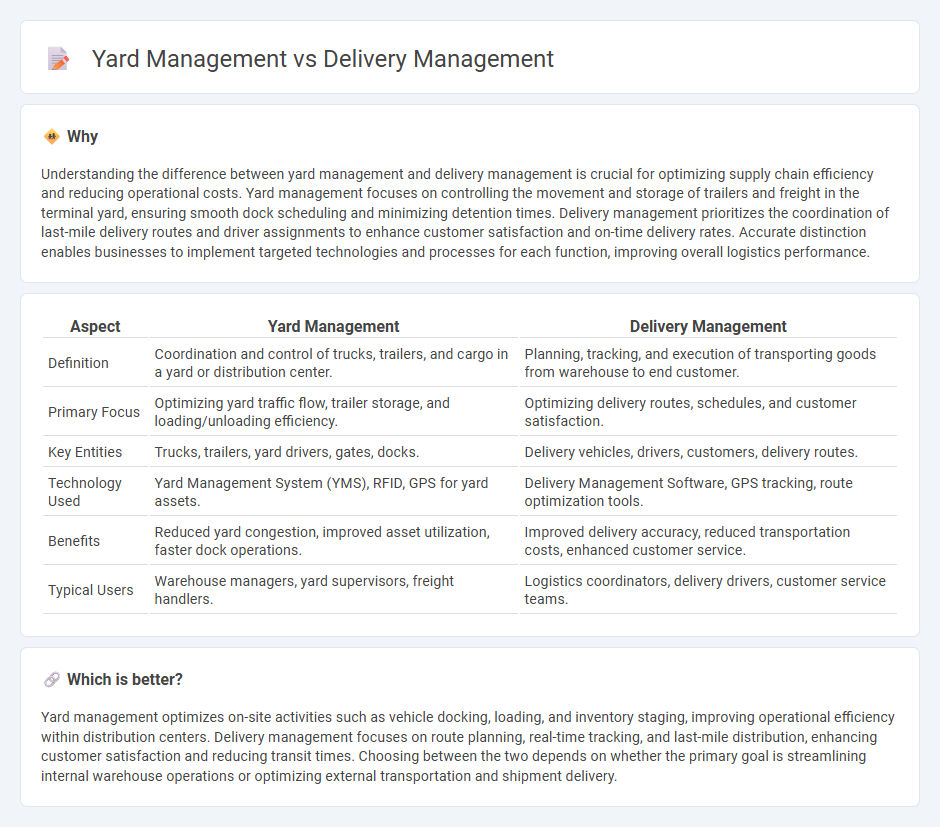
Yard management focuses on optimizing the movement and storage of vehicles and goods within a warehouse yard, ensuring efficient dock scheduling, inventory tracking, and space utilization. Delivery management, on the other hand, oversees the planning and execution of goods transportation from warehouses to end customers, emphasizing route optimization, real-time tracking, and timely deliveries. Explore the distinct benefits and technologies of yard management versus delivery management to enhance your logistics operations.
Why it is important
Understanding the difference between yard management and delivery management is crucial for optimizing supply chain efficiency and reducing operational costs. Yard management focuses on controlling the movement and storage of trailers and freight in the terminal yard, ensuring smooth dock scheduling and minimizing detention times. Delivery management prioritizes the coordination of last-mile delivery routes and driver assignments to enhance customer satisfaction and on-time delivery rates. Accurate distinction enables businesses to implement targeted technologies and processes for each function, improving overall logistics performance.
Comparison Table
| Aspect | Yard Management | Delivery Management |
|---|---|---|
| Definition | Coordination and control of trucks, trailers, and cargo in a yard or distribution center. | Planning, tracking, and execution of transporting goods from warehouse to end customer. |
| Primary Focus | Optimizing yard traffic flow, trailer storage, and loading/unloading efficiency. | Optimizing delivery routes, schedules, and customer satisfaction. |
| Key Entities | Trucks, trailers, yard drivers, gates, docks. | Delivery vehicles, drivers, customers, delivery routes. |
| Technology Used | Yard Management System (YMS), RFID, GPS for yard assets. | Delivery Management Software, GPS tracking, route optimization tools. |
| Benefits | Reduced yard congestion, improved asset utilization, faster dock operations. | Improved delivery accuracy, reduced transportation costs, enhanced customer service. |
| Typical Users | Warehouse managers, yard supervisors, freight handlers. | Logistics coordinators, delivery drivers, customer service teams. |
Which is better?
Yard management optimizes on-site activities such as vehicle docking, loading, and inventory staging, improving operational efficiency within distribution centers. Delivery management focuses on route planning, real-time tracking, and last-mile distribution, enhancing customer satisfaction and reducing transit times. Choosing between the two depends on whether the primary goal is streamlining internal warehouse operations or optimizing external transportation and shipment delivery.
Connection
Yard management optimizes the coordination of vehicles and inventory within the storage area, directly impacting delivery management efficiency by ensuring timely loading and dispatch. Integration of real-time yard data with delivery schedules minimizes delays and enhances supply chain visibility. Effective synchronization between yard operations and delivery routes reduces transit times and operational costs.
Key Terms
**Delivery Management:**
Delivery management optimizes the scheduling, routing, and tracking of shipments to ensure timely and efficient order fulfillment. Key components include real-time visibility, automated dispatching, and proof of delivery, which reduce delays and improve customer satisfaction. Explore how advanced delivery management systems can transform logistics operations for your business.
Route Optimization
Delivery management focuses on route optimization by planning efficient paths for timely deliveries, minimizing fuel consumption, and reducing transit times. Yard management optimizes vehicle movements within the yard to ensure smooth loading, unloading, and dispatch processes, preventing delays at docking points. Explore how integrating route and yard management can maximize operational efficiency and lower logistics costs.
Proof of Delivery
Proof of Delivery (POD) plays a critical role in both delivery management and yard management by ensuring accurate confirmation of goods receipt. Delivery management centers on tracking shipments from dispatch to customer, capturing POD to validate successful delivery and customer satisfaction. Explore how integrating POD enhances efficiency and accountability across delivery and yard operations.
Source and External Links
What Is Delivery Management System? A Comprehensive Guide - Delivery management coordinates order processing, logistics planning, route optimization, and real-time tracking to streamline deliveries, reduce costs, and improve customer satisfaction, using software tools to enhance supply chain efficiency.
What is Delivery Management? Importance + Expert Tips - ShipBob - Delivery management oversees the transport of finished goods and can be improved by selecting the right technology with features like real-time tracking, analytics, and route optimization, alongside robust inventory management to ensure timely fulfillment.
Supply Chain Delivery Management - Expeditors - Delivery management as a managed service provides active oversight of container shipments from vessel departure through delivery, focusing on reducing costs, increasing visibility, and ensuring on-time delivery through centralized data and expert coordination.
 dowidth.com
dowidth.com